MANUSCRIPTS NOT ACCESSIBLE BETWEEN AUGUST 23 AND NOVEMBER 17 2013
Owing to essential maintenance work in the storage areas of the British Library, the Stein Dunhuang and other Central Asian manuscripts will not be available for study on the dates above. The dates are still to be confirmed, please email IDP or look on the IDP home page for further updates.

Over the past three decades there have been systematic archaeological excavations of sites belonging to the ancient kingdoms of Khotan and Kroraina in the southern Taklamakan and Lop deserts, in modern-day western China. These have been carried out by Chinese archaeologists, some in conjunction with Japanese and French teams.
The exploration of these kingdoms, however, began much earlier. Early in the twentieth century Sven Hedin and Aurel Stein uncovered significant archaeological remains and brought the importance of these cultures to the attention of an international scholarly public. The materials they excavated are now in various collections in Europe and worldwide, and their influence on modern understanding of Central Asian history and society is without parallel.
This conference, the first on the topic, was organised by IDP UK, SOAS at The University of London and the Xinjiang Institute of Archaeology and held at SOAS and the British Library. It set the sites in context by looking at the historical geography and environment, the transmitted and excavated historical records, and archaeological archives in China and Europe.
It brought together an interdisciplinary group of scholars, including field archaeologists from the Sino-Japanese and Sino-French excavations of recent decades, archivists, curators and historians working on the Hedin and Stein collections, and historical geographers, art historians, and historians from universities with a strong research record in this area.
A full report by Professor Dan Waugh is given in the following pages and the presentations in PDF and audio format are available to download on the conference web page.
The conference was generously funded by:
- The Chiang Ching Kuo Foundation for International Scholarly Exchange
- The Arts and Humanities Research Council
- The Sino-British Fellowship Trust
The conference took place as part of Asian Art in London 2012.
Archaeology of the Southern Taklamakan: Hedin and Stein’s Legacy and New Explorations
Daniel C. Waugh

It is over a century since the Swedish explorer Sven Hedin stumbled across remains of the ‘Southern Silk Road’ in the Taklamakan Desert and the British archaeologist Aurel Stein began their serious excavation. The substantial results of the early excavations are still yielding new information, and the expeditions of recent years under the auspices of the Xinjiang Institute of Archaeology (XJIA) have greatly expanded our knowledge of previously studied sites and uncovered stunning new material. Thus it was unfortunate that the archaeologists from Xinjiang, who were to have presented on their recent finds at this conference, could not attend. Nonetheless, the conference was very successful as a forum for reviewing the history of exploration in the Taklamakan and indicating the important ways in which new methodologies and recent multi-disciplinary analysis have been broadening our understanding about the early history of the Silk Road.
In his opening keynote lecture and in a second presentation, Håkan Wahlquist, curator of the Hedin collections at the Museum of Ethnography in Stockholm, drew upon the rich manuscript and photographic legacy of Hedin. He explained how he went from being an ‘accidental’ archaeologist during his early lone travels to organising the complex Sino-Swedish expedition of 1927–34. The help of Johan Gunnar Andersson, a geologist living in China who had developed a serious interest in palaeontology and palaeobotany, was crucial in gaining for Hedin the necessary permits from the authorities.
The Chinese archaeologist who accompanied the expedition, Huang Wendi, barely appears in the published reports: the results of his rather substantial survey and excavation work have been published only in Chinese. His involvement in the last phase of the expedition in 1934 in the Lop Nor area came as something of a surprise to Hedin; there is reason to think Huang had been sent to keep an eye on the Europeans and report whether they were violating the newly imposed rule that they were not to undertake any excavation. Huang’s accusations that they had been secretly uncovering buried treasure led to serious friction between Hedin and the Chinese authorities.
Bergman’s preliminary report on the expedition’s archaeological results appeared in 1939, but unfortunately he did not live to write a final report. In his second talk, Wahlquist summarized the history of how the expedition discovered the Xiaohe (‘Little River’) necropolis, whose full excavation, undertaken more than half a century later, has yielded such spectacular finds (see below).
The first full session of the conference opened with Tim Williams’s discussion of the studies undertaken for advising UNESCO whether the Silk Road should be selected as a transnational World Heritage site. An archaeologist at the University of London, Williams has been director of the Ancient Merv project. One of the challenges in the study for UNESCO has been the uneven nature of efforts to systematize archaeological data, to arrive at a standard listing of sites and names, and to correlate the often conflicting information about their exact location. The study has grouped sites under the topical headings of infrastructure, production and outcomes. The first group contains both man-made and natural features that facilitate trade and transportation; the second focuses on the production of goods to be traded and ideally would include extraction sites, though few have been identified. Outcomes are the results of contact and exchange, where sites might include shrines or pilgrimage destinations and be important for their representation of ideas. Since the database relies largely on what the partners provide, and there has been no uniformity in what they have chosen to emphasize, there are substantial difficulties in creating an integrated picture.
By first identifying key nodes, then route segments, it may be possible to define important corridors of exchange, which can be the focus of the the UNESCO nomination. The results of this study, including a long bibliography of publications in Chinese, Russian and English, will be posted on the ICOMOS website.
Philippe Forêt’s (University of St Gallen) paper previewed his forthcoming book concerning how important evidence gathered by Hedin, Stein and Ellsworth Huntington contributed to a broadly based scientific discussion a century ago regarding historic climate change. There was substantial evidence, some of it reported from the explorations, about the drying up of lakes, the death of cities, change in means of subsistence, and so on. However, the implications of what all this meant for human history were contested and often contradicted for ideological reasons by some establishment ‘colonialist’ geographers (especially at the Royal Geographical Society), with serious implications for the continuing study of climate change. While the paper did not draw this explicit parallel, its conclusions resonate with the debates even in our own time pitting ‘climate sceptics’ against scientists.
In a paper that connected in very interesting ways with Williams’s presentation, Michael Frachetti (Washington University, St Louis) argued on the basis of his ongoing excavations in the piedmonts of the Inner Asian mountains that what he calls an Inner Asian Mountain Corridor may have been one of the most important routes of communication and exchange dating at least as far back as the late Bronze Age. ‘Silk Roads,’ ‘steppe roads,’ and ‘ocean routes,’ all of which clearly became important in the centuries when we begin to have written documentation, were by no means the first to witness significant interactions which spread technologies of production and products. Sites in ecological zones thought to have been occupied at best seasonally and with temporary settlements have now been shown to have occupation layers extending over several millennia. As early as the third millennium BC, some of them reveal that the ‘nomads’ were acquiring grains such as wheat and broomcorn millet (mainly for ritual use), and within a millennium the inhabitants of these same areas had begun to cultivate those crops. There are parallels in the evidence about the early use of agricultural products found at Xiaohe. Simultaneously, the pastoralists were weaving cloth, increasingly of very fine quality, and developing bronze metallurgy. There is good reason to hypothesize that the piedmont zone formed the corridor through Inner Asia which brought some of the new technologies and products to China. Some of the most important results of the ongoing projects in Kazakhstan are from the work of Paula Doumani, a PhD candidate at Washington University who is working under Frachetti’s supervision.
Among the recent multi-year excavation projects in the Taklamakan has been the further exploration of sites along the Keriya River. Corinne Debaine-Francfort has played a key role in the joint project with XJIA and recently defended her doctorate on the results. She was in Urumqi and so Henri-Paul Francfort (CNRS, Paris) provided an overview of the results, focusing in particular on objects found at the mid-first millennium BC site of Djoumboulaq-qoum which illustrate long-distance connections — some with South Asia, some with Achaemenid Persia and many with the nomadic cultures of the steppe region and northern Central Asia. The material shows clearly the impact of local adaptation and has its own distinct features. Djoumboulaq-qoum has impressive fortifications, extensive remains of irrigated agriculture, and well-preserved organic materials. There is evidence for early iron technology. As Professor Francfort indicated, this raises all sorts of questions.
Devising new approaches to interpret finds of prestige objects in excavated tombs was the subject of Armin Schbitschka’s Munich dissertation and his talk, in which he also introduced material from his current research project on Chinese notions of the afterlife in the period from the fourth century BC to the first century AD. A good portion of his presentation addressed the methodological problem of how such goods have been treated to date, with scholars often emphasizing their connection with religious belief and ritual. There is still much to be done in trying to figure out how their creators and owners understood them: were they valued as status symbols, because of their cost, because of their exoticism? What might they indicate about social distinctions?
In the absence of Idris Abdurusul, XJIA, Henri-Paul Francfort commented on the rich visual presentation which Idris had sent, with photographs and drawings of the various stages in the excavation and of the striking finds. The presentation included a couple of tantalizing images from the more recently discovered but as yet not fully excavated northern cemetery site in the Keriya delta whose remains seem to have a great deal in common with those found at Xiaohe.
The summary of Idris’s paper included information on the DNA analysis and other studies of the floral and faunal remains from Xiaohe, showing that the wheat and cattle at the site undoubtedly were of west Asian origin. Analysis of the human remains reveals that the population was ethnically complex. Palaeoenvironmental analysis demonstrates that this now desert location was once abundantly watered.
Details concerning this analysis were presented by Leo Aoi Hosaya, an archaeobotanist at Kyoto University (her presentation prepared jointly with Yo-Ichiro Sato). As she explained, this work carried out between 2006 and 2011 was part of a collaborative project between Xinjiang and the Research Institute for Humanity and Nature in Kyoto. The Kyoto Institute is also collaborating with the Sven Hedin Foundation to digitise materials in the Hedin archive in Stockholm. The remains of Xiaohe wheat indicate that it was the common variety (triticum aestivum). While very productive, this variety also requires substantial moisture. A time series comparing the weight and abundance of the wheat grains over the centuries of the Xiaohe cemetery reveals an apparent improvement in wheat yields up until nearly the end, but then a sharp drop-off, suggesting some kind of crisis as far as local agriculture was concerned. Pollen analysis confirms a trend away from plants requiring abundant moisture and toward those which thrive in a drier climate. While many questions here remain to be answered by more broadly based data, the Xiaohe evidence suggests at least the possibility that the crisis which led to the end of the ‘Xiaohe culture’ may have been man-made. Increasing use of irrigation to expand agricultural production had the drawback of increasing soil salinity and ultimately making it impossible to grow crops.
Given the emphasis of several of the papers on agricultural production and irrigation systems, Arnaud Bertrand’s PhD dissertation work at the Sorbonne has particular relevance. His focus is on water management in Niya and other areas of the Tarim Basin; the paper he gave here discussed Stein’s (and more recent) evidence about water tanks and canals. The Niya documents hold some information. Correlating this with that of archaeology suggests that, contrary to some earlier beliefs, the techniques of water management probably were not introduced to Niya by Chinese garrisons sent into the Tarim Basin. The models might have come from west or south Asia, but Bertrand suggested that it may well be that we should look locally for the expertise.
The written documentation from Niya was the focus of the presentation by Stefan Baums (University of Munich). Stein and later excavators found hundreds of documents, the great majority of which were wooden tablets, containing Prakrit-language texts written in Kharoṣṭhi script. If the earliest efforts of a century ago to decipher the Gandhari language relied on very few and fragmentary texts, there is now an abundance of material, including not only the administrative documents from Niya but a range of other inscriptional and manuscript sources. Important collections of Buddhist texts on birchbark have surfaced in recent years and are the subject of the Early Buddhist Manuscript Project at the University of Washington, in which Baums is an active participant. After characterizing the range of textual material, he described current publication projects including editions of previously unknown material, revisions of the translations and transcriptions of the Niya documents, an annotated catalogue of the texts and compilation of a Gandhari dictionary. This material will be available online.
Valerie Hansen of Yale provided an overview of what a combination of the written and archaeological evidence tells us about Niya’s history. In particular she emphasized the distinction that needs to be made between transmitted (intentional) and excavated (non-intentional) sources, the former including narrative texts such as dynastic histories and pilgrimage accounts, and the latter documents such as the Niya woodslips. The transmitted sources may be at odds with the archaeological record and may be silent about some of the more interesting material revealed only by archaeology. In general, if we are to learn about daily life, the excavated sources are critical.
While artefacts and texts were the focus of several of the papers, Puay-Peng Ho (Chinese University of Hong Kong) looked at the evidence from architecture. His paper drew on excavation material from various periods, including that from Dandan Uiliq and Rawak, and he introduced comparisons from Buddhist architectural traditions in India and cave architecture at some of the important sites in China. However, given the fact that so much excavation is still needed — for example, extending beyond the immediate area of the Rawak stupa — any kind of generalization about architectural models, influences and so on seems to be premature.
In recent decades, some of the most important new survey excavation in the Taklamakan has been carried out by joint Sino-Japanese teams: in 1988–97 at Niya and in 2002–6 at Dandan Uiliq. Kojima Yasutaka, Chair of the Academic Research Organization for Niya at Bukkyo University, reported on these projects, in which he was one of the prime movers (and funders). The work at both sites uncovered hundreds of new structures, extended substantially knowledge of the areas occupied by the sites (for example, at Niya, habitation 40 km north of the areas excavated by Stein was identified), uncovered new sets of documents, Buddhist paintings and much more. Among the more striking discoveries were what have been identified as ‘royal burials’ at Niya, the bodies covered in well-preserved silk textiles. The projects are interdisciplinary and involve application of sophisticated conservation techiniques. Apart from this work, Yasutaka has supported scholarship programs and the building of schools in Xinjiang, all evidence of his intense personal commitment to the region’s history and to its current population.
Whether or not they were used as money (commonly not, according to numismatic expert Joe Cribb of the British Museum), coins are among the most important of our sources regarding the history of the Tarim Basin and often are misunderstood or ignored by non-specialists. Cribb has been studying the coins of the Silk Roads for decades. He summarized his work on Sino-Kharoṣṭhi coins, issued by the rulers of Khotan, showing details of the kinds of information contained in their inscriptions and iconography to illustrate the challenges of their study. Careful examination of all known examples (some 470) is essential, since often inscriptions are only partially legible and need to be ‘filled in’ from legible parts on other examples. Even though these coins of Khotan contain Chinese inscriptions, their basic form and models came not from China but from the Kushan/Yuezhi territories of the west and south. They enable us to flesh out the disputed chronology of Khotanese rulers, something which cannot be established simply on the basis of other extant written evidence. Yet there are challenges in this, since the names on the coins generally do not match the names of the same rulers as attested in the Chinese sources.
The sparse written documentation for Khotan includes a recently discovered wooden administrative tablet, overlapping in content with one previously published. They record taxes and distribution of grain in a village in the region of Khotan. Wen Xin (Harvard) is working on these with his supervisor Oktor Skjærvø and reported on the information they contain on Khotanese society and administration. The village involved in the transactions had a communal granary and a form of communal ownership of food resources; the document provides a picture of how the grain collected as a tax was then re-distributed to various social groups.
Helen Wang (Keeper of East Asian Money in the British Museum) provided an overview of some of the different types of coins found along the Silk Road and other types of money such as ingots. She presented a preview of the results of a collective project to explore the role of textiles as money, moving beyond the long-recognized fact that prices often were measured in bolts of silk. One of the challenges is to determine the value of a particular textile, which sometimes can be done on the basis of inscriptions that might record its size and its value equivalent in coins. The results of this project are about to be published in a special number of the Proceedings of the British Academy.
The concluding reports concerned online resources. Helen Persson, V&A curator, spoke of the ongoing work to make the Stein textiles more accessible online with informative web pages on Stein and his work. A recent IDP initiative was to re-visit some of the sites where Stein worked and re-photograph them, attempting to replicate the exact angles and positions of Stein’s photos to facilitate comparison. John Falconer, Lead Curator of Photographs at the British Library, illustrated some of these striking comparisons. A report on this project is in IDP News 39.
IDP provided some summary remarks in conclusion, emphasizing the complexities of analyzing the history of the Silk Roads but also the richness (if unevenness) of the evidential data and the need for continuing collaborative projects. Additional concluding remarks were made by Lucas Nickel of SOAS, who likewise emphasized the unevenness of the available evidence. The legacy of the pioneers in the exploration of the Silk Roads continues to be appreciated, but it is important to build on the insights of a conference such as this, one possible step being to publish its proceedings.
Daniel C. Waugh is a Professor Emeritus, University of Washington; Department of History; Henry M. Jackson School of International Studies; Department of Slavic Languages and Literatures.
Archaeological Discoveries in Domoko
Wu Xinhua

A renowned centre of Buddhism, the old kingdom of Khotan has had an influence on Buddhism in central China and across East Asia that continues to the present. Most Buddhist sites of the Tarim Basin are found here. The artefacts from sites in Qira and Yutian (Keriya) counties, with Domoko at their centre, are both numerous and important.
At the start of the twentieth century, large numbers of Buddhist artefacts were excavated from sites discovered along the waterways of Domoko: Khadalik, Kokjigedai, Balawaste, Old Domoko, Uzun-tati, Karaqin and Dandan Uiliq. From 2000, the Xinjiang Archaeological Team of the Institute of Archaeological Research, Chinese Academy of Social Sciences discovered other sites when working in the area, including Huyangdun, Kalakalegan, Tuopulukedun, Karadong, Abasidun, and Speer old town.
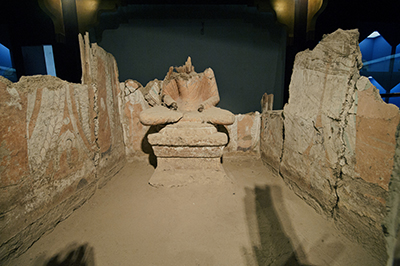
With the Taklamakan desert to the north and the Kunlun mountains to the south, the Domoko region has a typically continental, extremely dry climate, which aids the preservation of organic artefacts. Among the artefacts excavated were Khotanese, Prakrit and Chinese texts. The non-Chinese texts featured loanwords from Chinese, Sanskrit and Persian. Place names such as Domoko and Gulahama are remnants of the local ancient languages. ‘Domoko’ consists of the old Keriyan word loaned from the Sanskrit ‘Dharma’ with affix ‘go’, meaning ‘Dharma crossroads’, and transliterated into Chinese as Damogou (达摩沟).
Excavations of Tuopulukedun Buddhist Temple 1 started in autumn 2002. This is the best preserved Buddhist temple uncovered in the Taklamakan to date and it is possible to establish the temple’s original appearance based on the remains. Temple 2 was uncovered in May/June 2006, and Temple 3 in May/June 2010. Temple 3 is a temple complex, with areas for accommodation, study and sutra recital, the first such to be unearthed in the Taklamakan. It was part of a monastery, along with Temples 1 and 2. Its square courtyards, monks’ cells, and lotus-shaped cookware are also unique. The courtyards are very similar to those built in this region today.

In 2011–12, separate archaeological surveys were carried out in Karadong, Abisidun and Huyangdun. Excavations at the Huyangdun Buddhist temple revealed the remains of the Taklamakan’s largest 回-shaped Buddhist temple hall. Radiocarbon dating places it at the end of the third century making it the earliest temple structure in the whole region. It has provided evidence that the 回-shaped Buddhist temple hall originates in the Tarim.

Wu Xinhua is a professor at the Institute of Archaeology, Chinese Academy of Social Sciences, and was Team Leader on these excavations.
Reference
巫新华等, ‘新疆和田地区策勒县达玛沟佛寺遗址发掘报告’《考古学报》 2007年04期 (view abstract online) , 489-525页.
The Materials of Turfan and Dunhuang Manuscripts: Analysis of Paper, Pigments and Dyes
Renate Nöller and Agnieszka Helman-Wazny
The great variety of manuscripts found in the Turfan oasis at the start of the twentieth century by Grünwedel and Le Coq reflects the cultural backgrounds of, and communication among, the people who travelled along the network of Eurasian trade routes. Specifically, this connection is directly reflected by the use and distribution of inks, pigments, and papers. Research is now underway to examine these and a report on the initial findings is given below.
Collections
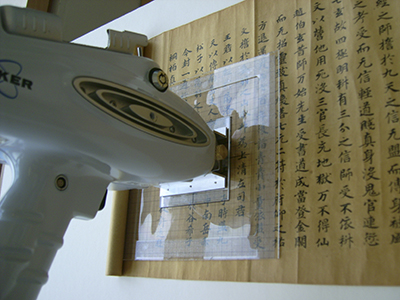
The Turfan collection deposited in the Berlin-Brandenburg Academy of Sciences and Humanities (BBAW) and the Berlin State Library has been studied in cooperation with the Federal Institute for Materials Research and Testing (BAM), Berlin (Renate Nöller) and with the University of Hamburg, Asia Africa Institute (Agnieszka Helman-Wazny). In addition, illuminated manuscripts from the Berlin State Museums, Museum of Asian Art, and manuscripts from the Stein collection of the British Library, London are being used as reference material. The research is funded by the German Research Foundation (DFG) for a three year period.
Analysis

Analysis of the writing material was conducted on site using non-destructive methods: visible spectroscopy (VIS) for the primary characterization of inks and pigments; mobile X-Ray Fluorescence Spectroscopy (ARTAX/TRACER) for elemental analysis (right, top); and FTIR (EXOScan) to determine chemical composition. A transmitted-reflected light microscope with BF/DF/DIC/PL was used for fibre analyses of the paper. Image-Pro Plus software was utilized for image analysis during identification.
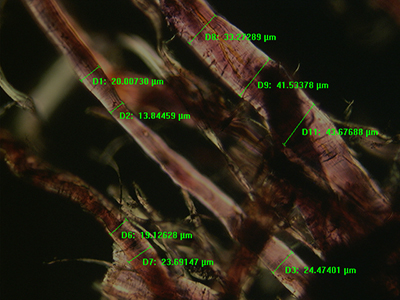
Careful attention to paper at microscopic scale reveals which plants were used for paper making and the methods of paper production, by characterizing the paper optic and identifying fibre composition. Technological features of paper — such as the presence of laid and chain lines from the papermaking sieve — were checked using a light box. Woven or laid papers were identified and measurements of laid lines in 3 cm and chain line intervals, if visible, entered into the IDP database. Fibre distribution within a sheet marks whether the fibres were poured into the floating mould and distributed by hand or scooped by the mould from a vat, and how quickly drainage of the pulp took place. The number of layers, thickness, and other visual features of paper, such as texture or presence of yellow dye, were documented. Photographic documentation of the paper structure against a light source was also carried out.
As part of the workflow the manuscripts, stored mainly under glass, were cleaned and newly restored.
Initial Results
The initial results showed the Uighur manuscripts contained the greatest variety of material.
We found bark paper including Daphne/Edgeworthia sp., straws and even a bamboo addition (right, middle), which suggests a later date for these manuscripts. Some of the papers show new plant resources; however, the fibre shape/state of preservation suggests very primitive technology. Bark paper became popular in China during the second half of the first millennium. Made out of the woody plant-based fibres derived from the bark of paper mulberry and mulberry, it is usually of high quality. Bark paper made of paper mulberry fibres is significantly represented among both Turfan and Dunhuang manuscripts. Bark paper has also been used from as early as the eighth century by Tibetans, but made from Daphne and Edgeworthia sp.
Indigo, detected with VIS, was present in a sheet of dark blue paper, suggesting the wealth of the late Uighur period. This hypothesis is further supported by examination of the pigments used. The most precious materials identified by analysis of elements with ARTAX are pure gold and orpiment, a yellow arsenic trisulfide. Only a few manuscripts from other cultural groups have been found containing orpiment. The Periplus of the Erythrean Sea, a document probably written in the first century AD, records this pigment as an item of trade at the Indian port of Bharuch, Gujarat. The pigment had already been exploited in Greece and Iran (Bisutun Kermanshah) in very early times. The analysis of mineral pigments from different sources shows specific elements typical for the geology of a particular region. Compared with those detected on the manuscripts, these pigments may serve as a fingerprint for the determination and characterization of the writing material.
Manuscripts with Uighur on one side and Chinese on the other side were written with black carbon inks. However, the ink shows differences in composition, changing over a period of about 300–500 years. The script with ornamentation on Iranian-Manichaean manuscripts is exceptionally fine. Different types of papers show blue inks, presumably created with imported pigments. The main deposits of blue lazurite (lapis lazuli) are in Afghanistan, where it has been mined for 6000 years. The identification of rare pigment from this mineral on the fragments can be seen as a further indication of distant trading contacts. Most of the red inks used, including those on stamps, show a mixture of cinnabar with red lead. Iron-red alone is seldom used. Inks of identical compositions show different colouration due to bleaching.
Independent of cultural affiliation, rag paper based on ramie and hemp fibres (right, bottom) represents a significant proportion of Turfan and Dunhuang manuscripts. Rag paper is the most commonly seen paper in the first millennium AD. Recycled paper made of rag waste was probably produced in large quantities the Dunhuang area. Scholars now argue that rag paper was invented in China prior to Cai Lun, who is credited in textual sources with the invention of paper in AD 105, composing it from ropes, broken fishing nets, rags, the soles of shoes and other material. Rag paper seems to have declined in use from the tenth century because of the shortage of raw materials and the high production cost. Chinese documents about papermaking after the Song Dynasty (960–1279) mention rag paper only occasionally, and its reduction is also confirmed by the greater variety of plant components identified in manuscripts from this period onwards.
The investigation uncovers clues about the different kinds of application and preparation of mineral pigments and plant fibres used for writing in Asia and, with this knowledge, we can start to understand the geography and history of ink and papermaking. The manuscripts already analysed show a great variety of papers and compositions of inks.
This study will map the origin and distribution of the various materials used in preparing manuscripts through studying the availability of natural resources along the Silk Road. We will also explore the techniques used in the scriptoria to prepare pigments and plants in order to make the ink and paper.
By looking at the materials used and reviewing their distribution alongside the distribution in time and space of different cultural groups, we have the possibility to date the manuscripts, or at least for revealing links between groups of objects with the same features and the cultures of people who met in Turfan and Dunhuang and exchanged their knowledge over long distances and periods of time.
Workshop on Codicology of Hanzi Scripts
11–13 March 2013 Omiya Campus, Ryukoku University, Kyoto, Japan. Organised by: President, Professor Ishizuka Harumichi with Chairman, Professor Toyoshima Masayuki.
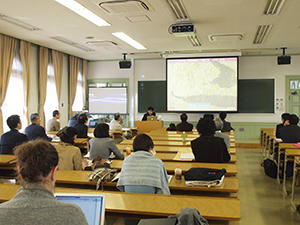
This international workshop brought together presentations on research over the past few years on the codicology of Dunhuang and other Central Asian manuscripts in Japan, Britain and France, and introductions by the curators of these and other related collections. The presenters included Dr Sakamoto showing the results of his recent research in Paris, following his work at the British Library (pictured), and Frances Wood and Susan Whitfield of the British Library, and Nathalie Monnet of the BnF.
A booklet is being compiled by Professor Ishizuka entitled Elements of Codiocology of the Hanzi Script and details will be given in a forthcoming issue of IDP News. His keynote presentation was based on this work.
Publications
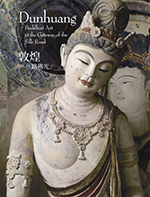
Dunhuang: Buddhist Art at the Gateway of the Silk Road
Fan Jinshi and Willow Weilan Hai (eds.)
Dunhuang Academy and China Institute Gallery 2013 PB, 126 pp., $45
ISBN: 9780977405497
China Institute website
The Silk Road: A Very Short Introduction
James A. Millward
Oxford University Press 2013
PB, 160 pp., 9 b&w, 1 map, £7.99
ISBN: 9780199782864
Oxford University Press website
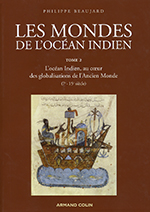
Les mondes de l’océan Indien
2 Vols.
Philippe Beaujard
Paris: Armand Colin 2012
Vol. 1: HB, 648 pp., 42 maps, 21 figs., 40 plates all colour, €65 ISBN: 9782200277086 Vol. 2: HB, 576 pp., 24 maps, 25 figs., 56 plates all colour, €65
ISBN: 9782200277093
Editions Armand Colin website
Note: both volumes currently on offer at 5% discount.
The History of Central Asia Vol. 1: The Age of the Steppe Warriors
Christoph Baumer
London: I. B. Tauris 2012
HB, 372 pp., colour and b&w, £25
ISBN: 9781780760605
I.B.Tauris website
英藏敦煌醫學文獻圖景與注疏
Images and Commentary on Dunhuang Medical Manuscripts in British Collections
王淑民
Wang Shumin
Beijing: People’s Medical Publishers 2012
HB, 264 pp., 150 colour, RMB168
ISBN: 9787117156431
A catalogue of the medical manuscripts in the British Library following years of research by Wang Shumin, with full colour illustrations provided by IDP. You can read about Wang Shumin’s research on IDP’s Research page and access her online catalogue.
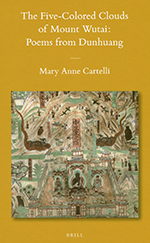
The Five-Colored Clouds of Mount Wutai: Poems from Dunhuang
Mary Anne Cartelli
Sinica Leidensia, Vol. 109
Leiden: Brill 2012 HB, 224 pp. €94, US$129
ISBN: 9789004184817
Brill website
The Guyuan Sarcophagus: Motifs from Asia 3 Vols.
Rosalind E. Bradford
Saarbrücken: LAP Lambert Academic Publishing 2011–12
ISBN: 9783843389853 9783845410531/9783847309864
Each volume €79
LAP Publishing website
Дуньхуановедение: перспективы и проблемы второго столетия исследований
Dunhuang Studies: Prospects and Problems for the Coming Second Century of Research
敦煌學: 第二個百年的研究視角與問題
I. Popova and Liu Yi (eds.)
St. Petersburg: Slavia Publishers 2012
HB, 366 pp.
ISBN: 9785950102196
IOS publications
Literature and History of the Western Regions 6 (2012)
西域文史
朱玉麒
Zhu Yuqi (ed.)
366 pp., 4 pp. plates
ISBN 9787030304247
Research Center of Literature and History of the Western Regions website
The China Institute: Year of Dunhuang
The China Institute in New York is celebrating the site of Dunhuang through a year of exhibitions and programmes, details of some of which are given below.
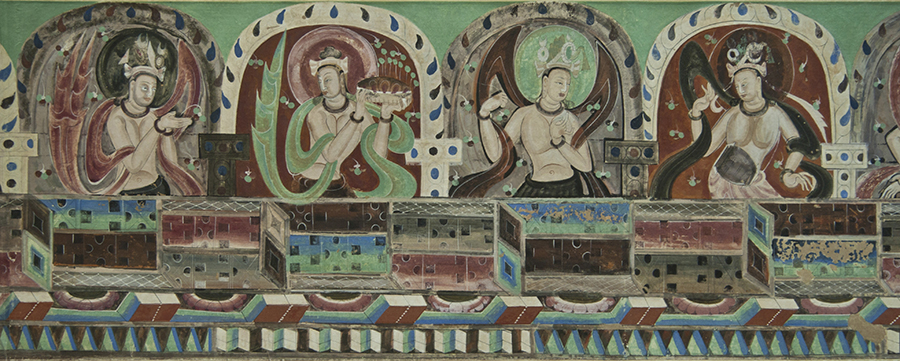
Replica in mineral pigments on paper by Shi Weixiang, 1974; 52 x 522 cm
Courtesy of the Dunhuang Academy.
Exhibitions
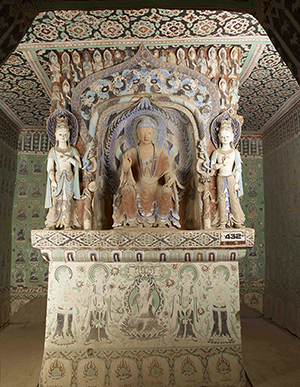
Dunhuang: Buddhist Art at the Gateway of the Silk Road
China Institute Gallery, New York
19 April – 21 July 2013
This exhibition showcases the customs and practices of local Buddhists in Dunhuang and illuminates the significance of the city as a crucial point of cultural exchange. The exhibits include sculpture, painted clay reliefs, calligraphy, Buddhist scriptures, and modelled bricks from the caves. There is an accompanying catalogue (see publications).
Inspired by Dunhuang: Re-Creation in Contemporary Chinese Art
China Institute Gallery, New York
19 September – 8 December 2013
Highlighting paintings and sculptures by a dozen modern and contemporary artists, this exhibition will explore Dunhuang’s influence on generations of artists beginning with master painter Zhang Daqian. Other artists to be featured in the exhibition include contemporary art luminaries such as Zhang Hongtu, Liu Jude, Liu Dan and Yu Hong. There is an accompanying catalogue.
Classes and Courses
Buddhism and World Cultures
A 12-week Course for Teachers
Autumn 2013
This course will explore the creation, growth, and influence of Buddhism in India, China, Korea, Japan, and the western world. Teachers will gain a solid background in this subject matter while exploring how best to integrate these issues into K-12 curriculum. The course will highlight effective classroom use of available on-line and printed resources related to Buddhism as well as demonstrate how these materials are consistent with NYC DoE standards and instructional principles geared towards student outcomes. Each three-hour session starts with a lecture and guided discussion and finishes with a group activity. Participants are required to submit a weekly course log that identifies how they would incorporate the material covered into their class aligned with relevant standards they must address; this weekly course log and participant work will be monitored and assessed by the course instructor and returned at the next course session with written feedback. Participants are expected to design and use an original lesson plan in their own classroom.
Drawing Buddha
Workshop for Teachers
Autumn 2013
This workshop will introduce teachers to the symbolism behind Buddhist iconography. As part of the workshop, participants will visit the galleries to practise reading the postures and gestures of various Buddha figures on display.
Teaching resources
China360 Online
To help contextualize cultural material from both Dunhuang exhibitions within a larger historic narrative, the China360online.org site is developing innovative and interdisciplinary educational and teaching resources that can be read by anyone seeking to learn more about Dunhuang and Buddhist art.
From Silk to Oil
From Silk to Oil: Cross-Cultural Connections Along the Silk Road, is a global studies curriculum funded by the U.S. Department of Education and produced by China Institute. It begins in the second century BC and ends in the contemporary period, and includes units on the Mogao Cave paintings.
IDP Worldwide
IDP Germany

The Berlin Brandenburg Academy of Sciences and Humanities hosted a German-Russian workshop on March 14–15 2013 where Russian scholars from the Hermitage State Museum and the Institute of Manuscripts of the Petersburg branch of the Russian Academy of Sciences met with their counterparts in Berlin. The meeting was made possible by the Berlin Brandenburg Academy’s funds for inter-Academy meetings and additional funding by the Prussian Cultural Heritage Foundation. The delegation from the Hermitage was led by Georgy Vilinbakhov, vice-president of the Hermitage, and by Irina Popova, head of the Institute of Manuscripts. The other Russian guests were: Olga Chunakova, Julija Elikhina, Natalia Kozlova, Maria Menshikova, Tatiana A. Pang, Svetlana Pankova, Kira Samosyuk, Elena Stepanova, Evgenij Kiy, Pavel Lurje and Nikolaj Pchelin. Sam van Schaik joined us from IDP London. The participants on the Berlin side were Yukiyo Kasai, Barbara Meisterernst, Simone-Christiane Raschmann, Christiane Reck, Lilla Russell-Smith, Mayke Wagner, Michael Balk, Desmond Durkin-Meisterernst, Christoph Rauch and Abdurishid Yakup.
On the first day the meeting took place in the Berlin Brandenburg Academy and was opened by Hermann Parzinger, the director of the Prussian Cultural Heritage Foundation, Irina Popova and Natalia Kozlova (pictured right). A full day of intensive presentations and discussions was rounded off by a visit to the Pergamon Museum.
The meeting continued on the second day in the Asian Art Museum in Berlin-Dahlem where Klaas Ruitenbeek and Lilla Russell-Smith were the hosts. As well as further presentations, Lilla Russell-Smith and Toralf Gabsch gave tours through the Central Asian exhibitions and the studio collection.
At the round table discussion in the afternoon various possibilities for exchange and partnership were discussed in a very constructive and friendly atmosphere, offering the prospect of further contacts and joint projects. A reception in the Museum given by the Asian Art Museum and the State Library, Berlin completed the meeting.
IDP Russia
Irina Popova attended the workshop in Berlin (see report under IDP Germany) along with colleagues from the Hermitage State Museum.
Several papers on Dunhuang manuscripts presented at the Dunhuang Studies conference (see publications) were made available on the IOM website.

IDP Sweden
Professor Håkan Wahlquist, Curator for Asia in the Museum of Ethnography, Stockholm, retired from this post in May (pictured right at the IDP Conference in November 2012). He remains Keeper of the Sven Hedin Foundation at the Royal Swedish Academy of Sciences and will continue his collaboration with IDP.
IDP France
Laurent Héricher returned to his post as Head of Oriental Manuscript Collections at the Bibliothèque nationale de France.
Nathalie Monnet attended the workshop in Japan (see previous article) and gave a paper on the Pelliot collections.
IDP Japan
Dr Shouji Sakamoto continues his analysis of the manuscripts at the Bibliothèque nationale de France and gave a paper on his results at the workshop held at Ryukoku University in March (see previous article).
IDP Korea
Issue 5 of IDP Seoul News has been published along with a new booklet giving details of their activities, publications and plans. For details please contact [email protected].
An Academic Advisory Board has been established and, during the visit of Susan Whitfield and Vic Swift to Seoul in March, they met the members and Susan Whitfield gave a paper on the recent work of IDP before the official Board meeting.
IDP Beijing
Mr. Wang Xing (王兴), undergraduate from Beijing Jiaotong University, continues work at IDP NLC as a volunteer. He comes to IDP NLC every Friday afternoon, and helps us to edit the XML file of Shen Guomei’s bibliography A Bibliographical Index of Dunhuang Manuscripts in NLC Collections (國家圖書館藏敦煌遺書研究論著目錄索引: 1900-2001).
The IDP NLC studio received support from the NLC to purchase ten 1TB mobile hard disc drives to save and transfer images. We also purchased a new Wacom tablet. Funding is now being sought for new and replacement camera set-ups for the NLC studio.
IDP Dunhuang
On 18 April 1982, the International Council of Monuments and Sites (ICOMOS) held a science symposium in Tunisia, coinciding with a meeting of the executive board in Hammamet. It was suggested that an International Day for Monuments and Sites be established. Once vetted by the executive committee, the suggestion was also approved at UNESCO’s 22nd General Conference, where a resolution was passed calling for all member states to promote and implement 18 April as the ‘International Day for Monuments and Sites’. When China joined ICOMOS in 1993, the Chinese Society for the Protection of Monuments and Sites (ICOMOS China) was duly established.
It was formally announced by ICOMOS that the theme of the International Day 2013 would be ‘Heritage of Education’. In response to appeals from ICOMOS, ICOMOS China called for further promotion and publicity regarding developments in China’s cultural heritage sector.
The Dunhuang Academy therefore held a special photographic exhibition entitled ‘The Technological Preservation of the Caves and Cultural Heritage of Dunhuang’. The exhibition served as a demonstration through images of the conservation measures, management procedures that went into the technological preservation of the caves and cultural heritage of Dunhuang, and the results that this achieved. It aimed to draw people into the stories behind the original artefacts, allowing them to further their understanding and awareness of these aspects of technological preservation at Dunhuang, and thereby offered the general public a unique opportunity to benefit from the scientific advancements in the field of cultural heritage.
The Dunhuang Academy is curator of an exhibition currently showing at the Asia Society, New York (see exhibitions).
Judith M. Boltz (1950–2013)
We were sad to hear of the death on March 25 2013 of Judith M. Boltz, Affiliate Associate Professor at the University of Washington. Judith Boltz worked for several months in 1992 at the British Libary on an index to the facsimile volumes of the non-Buddhist Dunhuang manuscript fragments, the prelude to IDP.
Her meticulous and scholarly approach was much valued and the catalogue entries produced during her time at the British Library were later made available online through IDP.
IDP UK
People

We were very sorry to say goodbye to Abby Baker and Rachel Roberts, both of whom had been with IDP for over ten years, starting work on the Mellon funded digitisation in 2001–2. Josef Konzcak has taken over as IDP Studio Manager (pictured top right with Sarah Mullan and Emma Goodliffe, who both joined IDP last year).
We were pleased to welcome two interns from the MA course in Managing Archaeological Sites at University College London. Wang Kexin and May Ho (pictured bottom right) were with IDP for five weeks in May to gain experience of working with and cataloguing collections. Kexin prepared the catalogue records for the Vincent photographs of Dunhuang (details in next newsletter) and May worked on checking and adding data on the Niya archaeological site.

Conferences and Lectures
IDP UK staff have attended several conferences over the past few months to give papers, including : Ryukoku University (see previous article); Royal Geographical Society AHRC-funded workshop ‘Re-enacting the Silk Road: Geographies and Geographers of Central Asia and the Silk Road’; University of Hamburg conference, ‘Manuscript and Xylograph Traditions in the Tibetan Cultural Sphere’; University of Gothenburg conference, ‘Trade and civilization in the pre-modern world’; and the Bochum University conference, ‘Empires of Faith.’
Susan Whitfield and Sam van Schaik have also given seminars and lectures to students including at The School of Oriental and African Studies, University of London (Diploma in Chinese Art and Indian Art), University College, London (MA Archaeology of Buddhism) and the University of Minnesota (MA Early Globalities).
In addition, Susan Whitfield gave a talk at the Asia Society, New York on the Silk Road and IDP for patrons of the Dunhuang Foundation.
New IDP Patron
We are delighted that James C. Y. Watt has agreed to join IDP as a patron. James Watt is curator emeritus of the Asian art department at the Metropolitan Museum of Art (MET), New York, following his retirement in 2011 after twenty-five years in the museum. He is also Senior Fellow in Residence at the Institute for the Study of the Ancient World (ISAW) in New York and the first J.S. Lee Professor of Chinese Culture at the Institute of Chinese Studies, the Chinese University of Hong Kong.
Before joining the MET, Watt was curator at the Museum of Fine Arts in Boston from 1981 to 1985. He also worked as head of the Board of Studies in Fine Arts at the University of China in Hong Kong and as curator of the Institute of Chinese Studies’ art gallery. While working at the MET, Watt curated several major exhibitions including ‘Splendors of Imperial China, Treasures from the Palace Museum, Taipei’ (1996), ‘China: Dawn of a Golden Age, 200–750 AD’ (2004–5), and ‘The World of Khubilai Khan: Chinese Art in the Yuan Dynasty’ (2010). He also co-curated ‘When Silk Was Gold’ (1997) with Anne Wardwell of the Cleveland Museum of Art.
Wikipedia Editathon
Following the success of the week-long editation held at IDP London last November (see IDP News 40), a further one day event was held at Nottingham University, co-organised with Professors Mike Heffernan and Julian Henderson. Students from Birmingham University also attended along with Professor Naomi Standen.
The workshop was funded by an AHRC grant to contextualise IDP resources. Since the workshop, IDP staff have continued to work on relevant Wikipedia pages, for example, creating pages on Miran Fort, Balawaste and Rawak Stupa and editing several other pages.
Data Consolidation
In preparation for the launch of the new IDP database and website, we have started a programme of checking, verifying and consolidating all the data relating to the manuscripts in the British Library before it is transferred to the new system. This work is being coordinated by Emma Goodliffe and she will give regular posts on progress on the IDP Blog.
Photographic Collections
Work started in February on digitisation of several photographic collections by IDP, including F. M. Bailey’s photographs taken on the 1903–4 Younghusband Mission to Tibet (Neg 1083) and Robert Byron’s collection of his 1933-34 travels (Neg 1240). All will become available online.

400,000 Images Online
In March 2013, IDP reached the target of 400,000 images freely available online. Newly-available images included those of Dunhuang manuscripts in China, produced by IDP Beijing; Sanskrit fragments from the British Library, enabled with the funding of IRIAB at Soka University; and Hedin photographs from Sweden, part of the new collaboration with institutions in Stockholm.
You can help us reach our next target of half a million images by sponsoring a sutra, becoming a regular IDP Supporter or giving a one-off donation. We are featuring some of our donors and supporters in a new series of short videos that will become available on the IDP YouTube channel over the coming months.
Relaunch of Sponsor a Sutra
Sponsor a Sutra, your opportunity to enable the reproduction of a Buddhist sutra just like the original patrons of the manuscripts, has been relaunched. We have a simpler pricing scheme, starting from just £35, and a new secure online payment system. You can add your own dedication or sponsor a sutra as a gift for a friend. All funds go directly to the digitisation work of IDP and enable us to make more material freely available online.
This digital version of IDP News is based on the print version of the newsletter and some links and content may be out of date.
This issue, No. 41, was published Spring 2013.
Editor: Susan Whitfield
Picture Editor: Josef Konczak
ISSN 1354-5914
All text and images copyright their creators or IDP, except where noted. For further information on IDP copyright and fair use, please visit our Copyright page.
For further information about IDP please contact us at [email protected] or visit our Contact page.